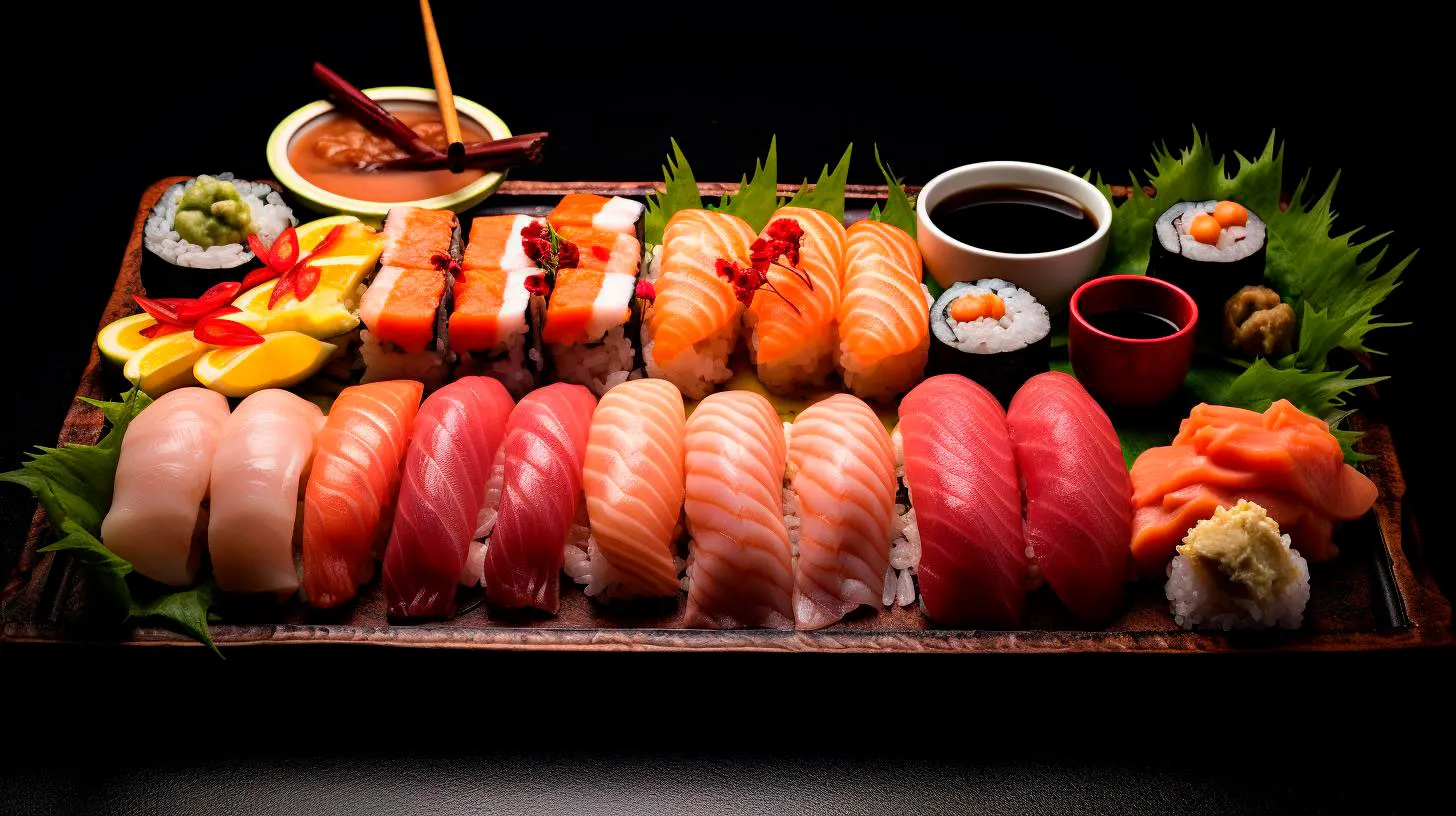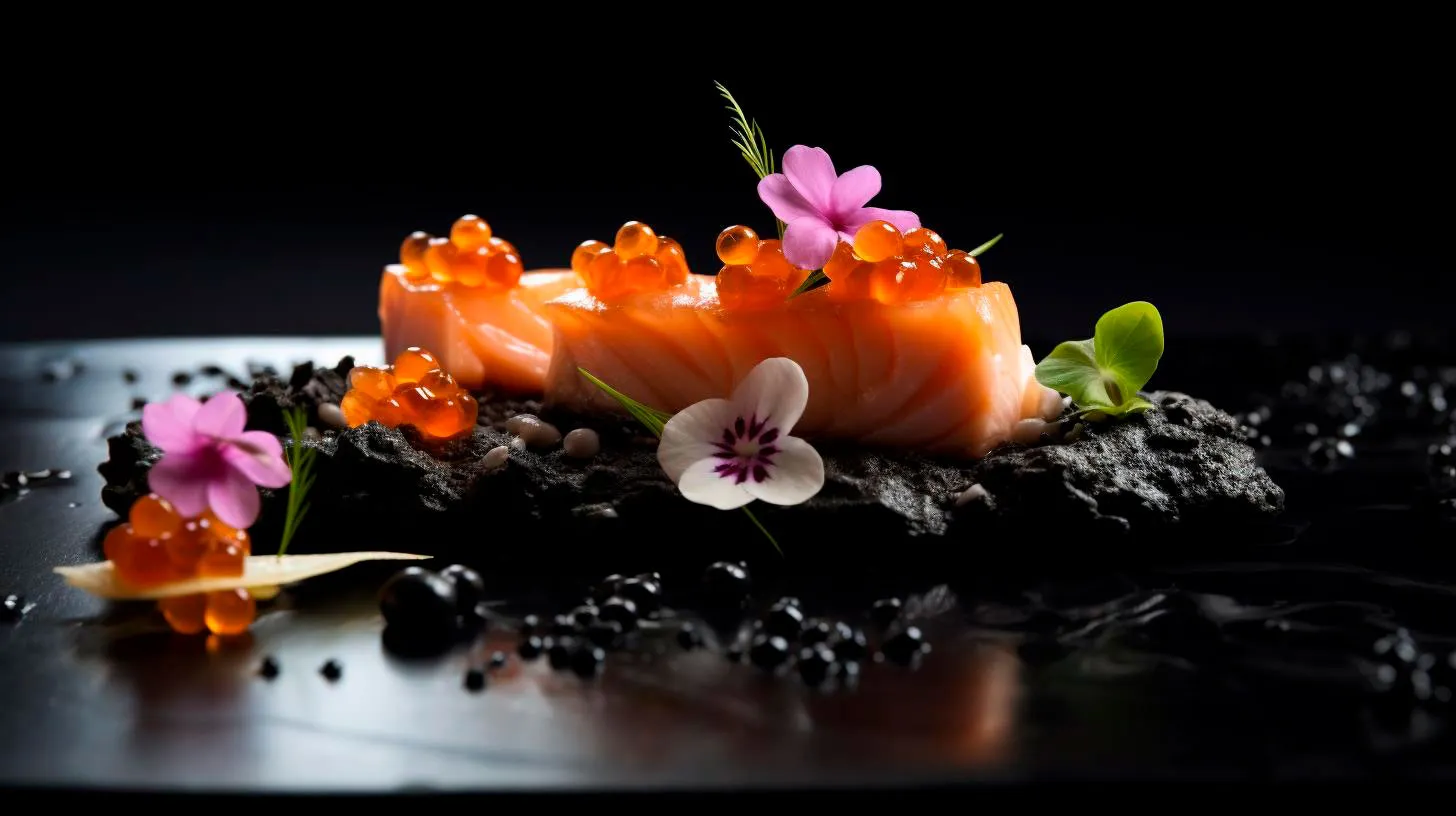A Journey Through Sushi Culture
Whether you’re a sushi enthusiast or simply curious about this iconic dish, join us as we dive into the depths of sushi culture.
The Origins of Sushi
Believe it or not, sushi traces its origins back to the 8th century in Southeast Asia. It initially served as a method of preserving fish by fermenting it with rice and salt. This early form of sushi was known as narezushi. Over time, the technique evolved, and it began being consumed along with the rice. The true transformation of sushi, however, happened when it reached Japan.
During the Edo period in Japan, sushi gained popularity as a fast food option among the bustling city dwellers. A street food vendor named Hanaya Yohei is credited with perfecting the technique of making nigiri sushi, the bite-sized delicacy we know today. Nigiri sushi consists of hand-pressed rice topped with fresh fish or other ingredients.
The Zen of Sushi Making
Sushi making is considered an art form in Japan, and skilled sushi chefs dedicate years to perfecting their craft. The process involves precision, attention to detail, and unyielding commitment to quality. From selecting the freshest ingredients to mastering knife techniques, every step is carefully executed to create a harmonious symphony of flavors.
Key Takeaway: The art of sushi making requires patience, precision, and a deep respect for tradition.
Types of Sushi
The world of sushi is vast and diverse, with various types to suit every palate. Here are a few popular sushi variations you might come across:
- Nigiri Sushi: Consists of a mound of sushi rice topped with slices of fresh seafood or other ingredients.
- Maki Sushi: Rolled sushi, typically wrapped in seaweed (nori) and filled with a variety of ingredients such as fish, vegetables, or even tempura.
- Sashimi: Slices of raw fish or seafood served without rice.
- Temaki Sushi: Also known as hand rolls, these are cone-shaped sushi rolls filled with a combination of ingredients.
Key Takeaway: Sushi offers a range of options, from delicate nigiri to flavorful maki rolls.
The Role of Wasabi and Soy Sauce
No sushi experience is complete without a dash of wasabi and a splash of soy sauce. Wasabi, a green condiment with a distinct spicy kick, adds a depth of flavor to sushi. Soy sauce, on the other hand, provides a savory umami taste that enhances the overall experience. However, it’s important to use these condiments sparingly, allowing the natural flavors of the sushi to shine through.
Key Takeaway: Wasabi and soy sauce complement sushi, but moderation is key.
Health Benefits of Sushi
Sushi is not only a delight for your taste buds but can also provide various health benefits. Here are some reasons why sushi can be a nutritious choice:
- Omega-3 Fatty Acids: Fish like salmon and tuna are rich in omega-3 fatty acids, which contribute to heart health and brain function.
- Lean Protein: Sushi provides a good source of lean protein, essential for building and repairing tissues in the body.
- Vitamins and Minerals: Sushi often includes vegetables like cucumber and avocado, providing a range of vitamins and minerals.
Key Takeaway: Sushi can be a healthy option, thanks to its omega-3 fatty acids, lean protein, and nutrient-rich ingredients.
Sushi Etiquette and Customs
When enjoying sushi, it’s important to be mindful of certain customs and etiquette practices. Here are a few guidelines to keep in mind:
- Use Chopsticks: Although it’s acceptable to use your hands for some types of sushi, using chopsticks is the traditional way to enjoy the delicacy.
- Dip Fish Side: When dipping nigiri sushi into soy sauce, it’s customary to dip the fish side, rather than the rice side, to avoid overpowering the delicate flavors.
- Finish It All: In traditional Japanese dining, it’s considered polite to eat everything on your plate, including the sushi pieces.
Key Takeaway: Understanding sushi etiquette enhances the overall experience and shows respect for the culture and traditions surrounding it.
Sushi Around the World
While sushi has its roots in Japan, it has gained immense popularity worldwide, with various adaptations to suit local tastes. Here are a few examples:
- California Roll: A westernized version of sushi, typically made with crab meat, avocado, and cucumber.
- Tempura Rolls: Sushi rolls filled with deep-fried tempura shrimp or vegetables.
- Sushi Burrito: A fusion creation that combines the convenience of a burrito with sushi ingredients.
Key Takeaway: Sushi has evolved globally, with unique adaptations to cater to different culinary preferences.
Sushi has truly come a long way since its humble beginnings. It has transcended boundaries and captivated food lovers worldwide. Whether you savor traditional nigiri or indulge in inventive rolls, sushi offers a journey through taste, culture, and artistry. So the next time you sit down to enjoy a plate of sushi, take a moment to appreciate the centuries-old culture that has shaped this iconic dish.
Unlocking the Secrets of Sushi
If you’ve ever wondered about the secrets behind sushi, this article will take you on a delightful journey, uncovering the fascinating aspects of this culinary art.
The Rich History of Sushi
Sushi traces its roots back to ancient Japan, where it was originally developed as a way to preserve fish. The word “sushi” actually refers to the vinegared rice that is the foundation of this dish. Over time, sushi evolved into an art form, with skilled sushi masters continuously innovating and perfecting their techniques.
Here are some key takeaways from sushi’s rich history:
- Sushi originated in Japan as a preservation method for fish.
- It has evolved into an art form with various regional and international styles.
- Traditional sushi-making techniques have been passed down through generations.
Types of Sushi
One of the secrets to sushi’s allure lies in its diverse range of styles. From nigiri to maki rolls, there is a sushi type to suit every taste preference. Let’s explore some popular sushi variations:
1. Nigiri Sushi
Nigiri sushi is a classic style that consists of a small mound of vinegared rice topped with a slice of fresh fish or seafood. This minimalist approach allows the flavors of the fish to shine through.
2. Maki Rolls
Maki rolls are perhaps the most well-known sushi style. They consist of a layer of sushi rice and various fillings such as fish, vegetables, or even meat, tightly rolled in a sheet of seaweed called nori. Maki rolls are often served cut into bite-sized pieces.
3. Sashimi
Sashimi is not technically sushi, but it is commonly found in sushi restaurants. It features thinly sliced raw fish or seafood served without rice. The focus is solely on the freshness and quality of the ingredients.
These are just a few examples of the many sushi variations that exist. Each type offers a unique taste experience and opens up a world of possibilities for sushi lovers.
The Health Benefits of Sushi
Besides its delectable flavors, sushi also offers numerous health benefits. The emphasis on fresh ingredients, lean proteins, and nutrient-rich seaweed makes sushi a nutritious choice. Consider the following advantages:
- Sushi is low in saturated fat and calories, making it a great option for weight management.
- The omega-3 fatty acids found in fish have been linked to a reduced risk of heart disease.
- Seaweed used in sushi is a rich source of vitamins, minerals, and antioxidants.
By choosing sushi as part of a balanced diet, you can indulge in a flavorful meal while reaping the rewards of its health benefits.
Sushi’s Global Impact
In recent years, sushi has expanded beyond Japan’s borders and captured the hearts and palates of people worldwide. Its popularity has led to the emergence of sushi bars and restaurants in every corner of the globe.
Here are some impressive statistics showcasing sushi’s global impact:
- The global sushi market was valued at $14.98 billion in 2020 and is projected to reach $22.72 billion by 2027.
- The United States is the largest consumer of sushi outside of Japan, with sushi restaurants numbering over 4,000.
- California rolls, a fusion style of sushi, were invented in Los Angeles in the 1960s and paved the way for sushi’s popularity in the Western world.
Sushi’s global reach highlights its universal appeal and the strong influence it has had on culinary traditions worldwide.
Conclusion
Sushi continues to captivate food enthusiasts with its delicate flavors, beautiful presentation, and cultural significance. Understanding the secrets and history behind this culinary art only enhances the appreciation for sushi’s extraordinary qualities.
Next time you savor a piece of nigiri or indulge in a maki roll, remember the rich heritage of sushi and the global journey it has embarked upon. From its humble beginnings as a preservation method to its current status as a world-favorite dish, sushi truly unlocks a world of flavors for all to enjoy.
Captivating Infographics on Sushi
In this article, we will explore some captivating infographics on sushi, highlighting its history, types, health benefits, and interesting facts.
A Little History of Sushi
Sushi is much more than just rolls of rice and fish. It has a rich history that spans over a thousand years. Here are some key points about the history of sushi:
- Sushi originated in Southeast Asia as a way to preserve fish
- In the 8th century, sushi arrived in Japan and evolved into the modern form we know today
- The Edo Period (1603-1868) brought considerable changes to sushi, with the introduction of vinegar-seasoned rice and the creation of nigiri sushi
- Sushi gained global popularity after World War II
The Many Faces of Sushi
Sushi is not limited to just one type. From classic rolls to more adventurous creations, there is an abundance of sushi varieties to satisfy every palate. Let’s take a look at some popular types of sushi:
- Nigiri Sushi: Hand-pressed sushi topped with fresh seafood or other ingredients
- Maki Sushi: Sushi rolls wrapped in seaweed (nori) and filled with a combination of rice, fish, and vegetables
- Sashimi: Slices of raw fish or seafood served without rice
- Temaki: Cone-shaped hand rolls filled with sushi ingredients
These are just a few examples of the vast sushi world. Exploring different types of sushi is not only a culinary adventure but also a great way to appreciate the artistry and skill that goes into its preparation.
The Healthy Side of Sushi
Aside from its exquisite taste and variety, sushi also offers numerous health benefits. Here are some reasons why sushi is a great choice for those seeking a healthy meal:
- Rich in Omega-3 Fatty Acids: Sushi, especially those with fatty fish like salmon and tuna, provide a good source of these essential fats known for their heart-healthy properties.
- Low in Calories: Compared to many other fast food options, sushi is relatively low in calories, making it a suitable choice for those looking to maintain or lose weight.
- High in Essential Nutrients: Sushi contains various vitamins and minerals, including vitamin A, vitamin C, iodine, and magnesium.
- Rich in Protein: With its fish and seafood components, sushi is a great source of high-quality protein, necessary for muscle repair and growth.
Fascinating Sushi Facts
Now that we have explored the basics, let’s dive into some fascinating facts about sushi:
- Over 22 billion pieces of sushi are consumed globally each year.
- The world record for the longest sushi roll is over 9,000 feet!
- The idea of using wasabi on sushi originated from its antibacterial properties, which helped ensure the fish stayed fresh.
- In Japan, it is considered a compliment to the sushi chef to loudly slurp your noodles.
Key Takeaways
Sushi is more than just a meal; it is an art form that has captured the hearts and taste buds of people worldwide. Whether you are a sushi aficionado or new to this culinary delight, exploring the captivating infographics on sushi can deepen your understanding and appreciation of its culture, history, and health benefits.
Remember, sushi offers a vast array of flavors, textures, and presentation styles that can cater to different preferences. So go ahead and indulge in this delectable dish while immersing yourself in the fascinating world of sushi!
Delving into the Origins
Get ready to explore the roots of innovation and gain a new appreciation for the technologies that shape our lives!
The Birth of the Internet
It’s hard to imagine a world without the internet, but it wasn’t always the omnipresent force it is today. The internet as we know it traces back to the late 1960s when ARPANET, the precursor to the modern internet, was developed by the United States Department of Defense. This groundbreaking network connected multiple computers, allowing for the exchange of information and research. Fast forward to 1989, and the World Wide Web was born, giving birth to the internet as we know it today. Some key takeaways on the origins of the internet include:
- The origins of the internet can be traced back to ARPANET in the late 1960s.
- The World Wide Web, developed in 1989, revolutionized the internet by making it accessible to everyone.
- The internet has since become an integral part of our lives, transforming the way we communicate, work, and access information.
Unveiling the Birth of Smartphones
Smartphones are now extensions of ourselves, allowing us to stay connected, informed, and entertained on the go. But where did it all start? The origins of smartphones can be traced back to the humble beginnings of PDAs (Personal Digital Assistants). In the early 1990s, devices like the IBM Simon emerged, combining a mobile phone with PDA features. Fast forward to 2007, and Apple’s iconic iPhone hit the market, revolutionizing the concept of smartphones. Some key takeaways on the origins of smartphones include:
- PDAs laid the foundation for smartphones, combining mobile phones with PDA features.
- The introduction of the iPhone in 2007 marked a turning point in smartphone technology.
- Today, smartphones have become an essential tool for communication, entertainment, and productivity.
The Revolutionary Blockchain Technology
Blockchain, the underlying technology of cryptocurrencies like Bitcoin, has gained considerable attention in recent years. But its origins can be traced back to a white paper titled “Bitcoin: A Peer-to-Peer Electronic Cash System” published by the pseudonymous Satoshi Nakamoto in 2008. Blockchain technology enables decentralized and transparent transactions, offering significant advantages in terms of security, efficiency, and trust. Some key takeaways on the origins of blockchain technology include:
- The origins of blockchain technology date back to a white paper by Satoshi Nakamoto in 2008.
- Blockchain allows for secure and transparent transactions without the need for intermediaries.
- It has the potential to revolutionize various industries, including finance, supply chain management, and healthcare.
Conclusion
Exploring the origins of technology gives us a deeper understanding of how far we have come and the incredible innovations that have shaped our world. From the birth of the internet to the rise of smartphones and the revolutionary potential of blockchain technology, these advancements have redefined the way we live, work, and connect with each other. As we continue to embrace the latest tech innovations, let’s not forget to appreciate the roots from which they have grown!



